explain in complete sentences what happens to supply or demand and what the new equilibrium is when
3.iii Demand, Supply, and Equilibrium
Learning Objectives
- Use demand and supply to explain how equilibrium toll and quantity are adamant in a marketplace.
- Sympathise the concepts of surpluses and shortages and the pressures on toll they generate.
- Explain the affect of a modify in demand or supply on equilibrium price and quantity.
- Explicate how the round menses model provides an overview of need and supply in production and factor markets and how the model suggests ways in which these markets are linked.
In this section we combine the demand and supply curves we have but studied into a new model. The model of demand and supply uses demand and supply curves to explain the decision of price and quantity in a marketplace.
The Determination of Cost and Quantity
The logic of the model of demand and supply is simple. The demand curve shows the quantities of a item expert or service that buyers will exist willing and able to buy at each price during a specified period. The supply curve shows the quantities that sellers will offer for sale at each price during that same period. By putting the ii curves together, we should be able to find a toll at which the quantity buyers are willing and able to purchase equals the quantity sellers volition offer for sale.
Figure 3.xiv "The Decision of Equilibrium Price and Quantity" combines the demand and supply data introduced in Figure 3.1 "A Demand Schedule and a Demand Curve" and Effigy 3.8 "A Supply Schedule and a Supply Bend" Discover that the two curves intersect at a cost of $6 per pound—at this cost the quantities demanded and supplied are equal. Buyers want to purchase, and sellers are willing to offer for auction, 25 1000000 pounds of coffee per month. The market for coffee is in equilibrium. Unless the demand or supply curve shifts, at that place will exist no tendency for toll to modify. The equilibrium toll in any market place is the price at which quantity demanded equals quantity supplied. The equilibrium price in the market place for coffee is thus $half-dozen per pound. The equilibrium quantity is the quantity demanded and supplied at the equilibrium price.
Figure 3.fourteen The Conclusion of Equilibrium Price and Quantity
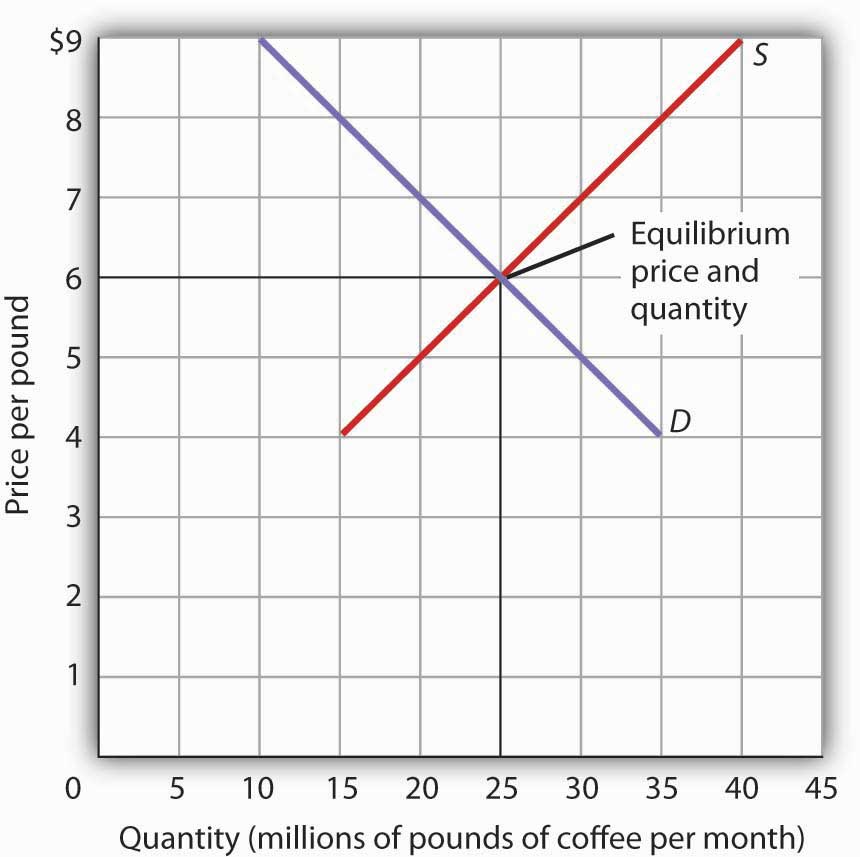
When we combine the need and supply curves for a good in a single graph, the indicate at which they intersect identifies the equilibrium price and equilibrium quantity. Here, the equilibrium price is $6 per pound. Consumers demand, and suppliers supply, 25 million pounds of coffee per month at this cost.
With an up-sloping supply curve and a downward-sloping demand bend, there is only a single price at which the two curves intersect. This means there is only one toll at which equilibrium is achieved. It follows that at any toll other than the equilibrium price, the market volition non exist in equilibrium. We next examine what happens at prices other than the equilibrium price.
Surpluses
Figure 3.15 "A Surplus in the Market for Coffee" shows the same demand and supply curves we take just examined, merely this time the initial cost is $8 per pound of coffee. Because nosotros no longer have a balance between quantity demanded and quantity supplied, this price is not the equilibrium price. At a price of $8, we read over to the demand curve to determine the quantity of java consumers will be willing to purchase—15 million pounds per month. The supply curve tells us what sellers will offer for auction—35 one thousand thousand pounds per month. The deviation, 20 million pounds of coffee per month, is chosen a surplus. More generally, a surplus is the amount by which the quantity supplied exceeds the quantity demanded at the current cost. At that place is, of course, no surplus at the equilibrium price; a surplus occurs only if the current toll exceeds the equilibrium price.
Figure three.xv A Surplus in the Marketplace for Coffee
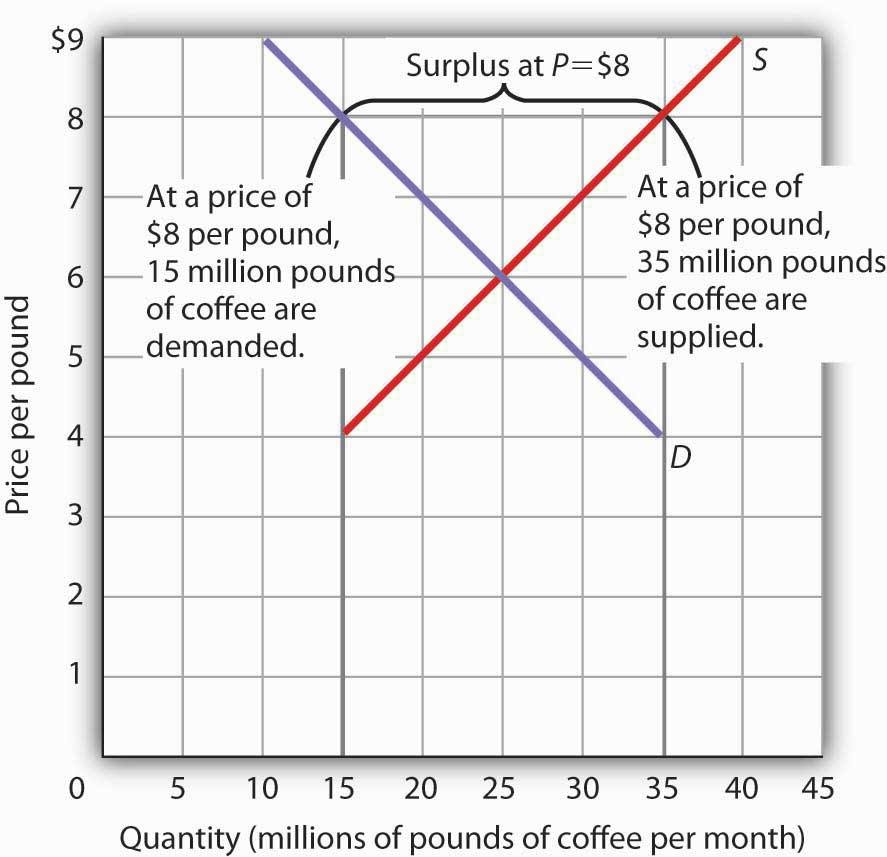
At a price of $8, the quantity supplied is 35 meg pounds of coffee per month and the quantity demanded is xv million pounds per month; there is a surplus of 20 million pounds of coffee per month. Given a surplus, the price will fall chop-chop toward the equilibrium level of $6.
A surplus in the market for coffee will non concluding long. With unsold coffee on the market, sellers will brainstorm to reduce their prices to articulate out unsold coffee. As the cost of coffee begins to fall, the quantity of coffee supplied begins to refuse. At the same fourth dimension, the quantity of java demanded begins to rise. Remember that the reduction in quantity supplied is a move along the supply curve—the bend itself does not shift in response to a reduction in price. Similarly, the increase in quantity demanded is a move along the demand curve—the demand curve does not shift in response to a reduction in cost. Price will go on to autumn until it reaches its equilibrium level, at which the need and supply curves intersect. At that betoken, there will be no trend for price to fall further. In full general, surpluses in the marketplace are short-lived. The prices of most appurtenances and services adjust apace, eliminating the surplus. Later on, we volition discuss some markets in which adjustment of price to equilibrium may occur only very slowly or not at all.
Shortages
Just as a price to a higher place the equilibrium price will cause a surplus, a price beneath equilibrium will crusade a shortage. A shortage is the amount by which the quantity demanded exceeds the quantity supplied at the current price.
Figure three.sixteen "A Shortage in the Market for Coffee" shows a shortage in the market for coffee. Suppose the price is $iv per pound. At that price, 15 million pounds of coffee would be supplied per month, and 35 one thousand thousand pounds would exist demanded per month. When more coffee is demanded than supplied, there is a shortage.
Effigy three.sixteen A Shortage in the Market for Coffee
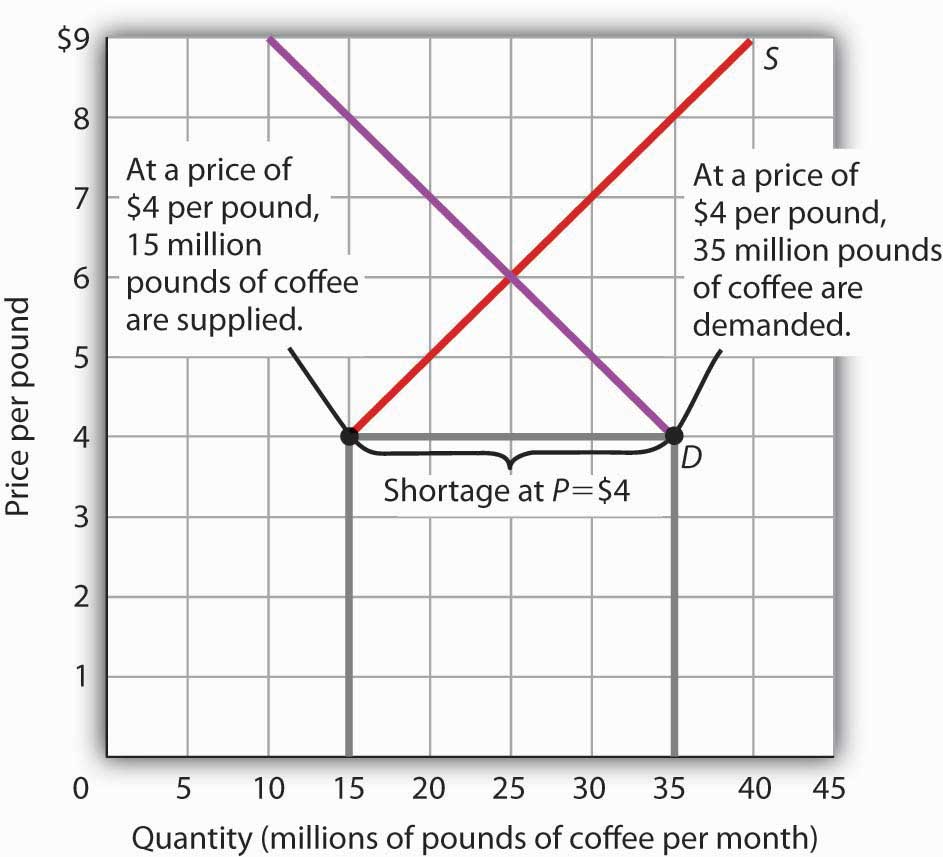
At a toll of $4 per pound, the quantity of coffee demanded is 35 one thousand thousand pounds per month and the quantity supplied is 15 million pounds per month. The result is a shortage of 20 1000000 pounds of coffee per calendar month.
In the face of a shortage, sellers are likely to brainstorm to heighten their prices. Equally the price rises, there will exist an increase in the quantity supplied (but non a alter in supply) and a reduction in the quantity demanded (but not a modify in need) until the equilibrium price is accomplished.
Shifts in Demand and Supply
Figure 3.17 Changes in Need and Supply
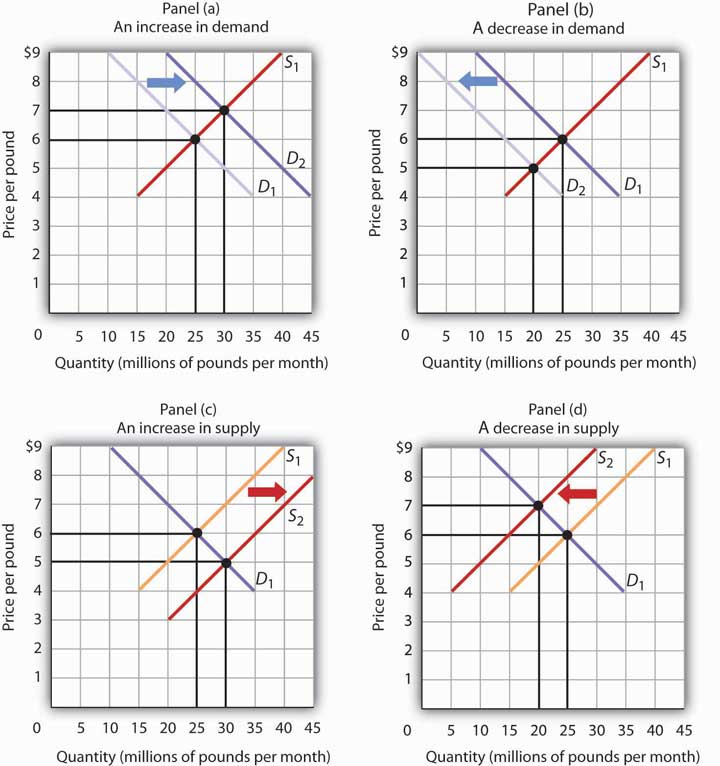
A alter in demand or in supply changes the equilibrium solution in the model. Panels (a) and (b) show an increase and a decrease in demand, respectively; Panels (c) and (d) show an increase and a subtract in supply, respectively.
A alter in i of the variables (shifters) held abiding in any model of demand and supply volition create a change in demand or supply. A shift in a demand or supply bend changes the equilibrium price and equilibrium quantity for a proficient or service. Figure 3.17 "Changes in Demand and Supply" combines the information well-nigh changes in the demand and supply of coffee presented in Figure 3.2 "An Increase in Demand" Figure 3.3 "A Reduction in Need" Figure 3.9 "An Increment in Supply" and Effigy 3.ten "A Reduction in Supply" In each case, the original equilibrium price is $six per pound, and the corresponding equilibrium quantity is 25 million pounds of coffee per month. Effigy iii.17 "Changes in Need and Supply" shows what happens with an increase in demand, a reduction in demand, an increase in supply, and a reduction in supply. Nosotros so look at what happens if both curves shift simultaneously. Each of these possibilities is discussed in plough below.
An Increase in Need
An increase in demand for coffee shifts the demand curve to the right, as shown in Panel (a) of Effigy 3.17 "Changes in Demand and Supply". The equilibrium price rises to $7 per pound. As the toll rises to the new equilibrium level, the quantity supplied increases to 30 million pounds of coffee per month. Notice that the supply curve does not shift; rather, there is a motility forth the supply curve.
Demand shifters that could cause an increase in demand include a shift in preferences that leads to greater coffee consumption; a lower price for a complement to coffee, such as doughnuts; a higher price for a substitute for coffee, such as tea; an increment in income; and an increase in population. A change in buyer expectations, perhaps due to predictions of bad weather condition lowering expected yields on coffee plants and increasing future coffee prices, could also increase current demand.
A Decrease in Demand
Console (b) of Figure 3.17 "Changes in Demand and Supply" shows that a decrease in demand shifts the need bend to the left. The equilibrium price falls to $5 per pound. As the price falls to the new equilibrium level, the quantity supplied decreases to 20 1000000 pounds of coffee per month.
Need shifters that could reduce the demand for coffee include a shift in preferences that makes people want to eat less coffee; an increase in the price of a complement, such every bit doughnuts; a reduction in the cost of a substitute, such equally tea; a reduction in income; a reduction in population; and a change in heir-apparent expectations that leads people to expect lower prices for coffee in the time to come.
An Increase in Supply
An increase in the supply of coffee shifts the supply curve to the right, every bit shown in Panel (c) of Figure 3.17 "Changes in Demand and Supply". The equilibrium toll falls to $five per pound. As the cost falls to the new equilibrium level, the quantity of coffee demanded increases to thirty million pounds of coffee per month. Discover that the need bend does not shift; rather, there is movement along the demand curve.
Possible supply shifters that could increment supply include a reduction in the cost of an input such as labor, a decline in the returns available from alternative uses of the inputs that produce coffee, an improvement in the engineering science of coffee production, skillful weather, and an increase in the number of coffee-producing firms.
A Decrease in Supply
Panel (d) of Figure 3.17 "Changes in Demand and Supply" shows that a decrease in supply shifts the supply curve to the left. The equilibrium price rises to $7 per pound. As the price rises to the new equilibrium level, the quantity demanded decreases to 20 million pounds of coffee per calendar month.
Possible supply shifters that could reduce supply include an increase in the prices of inputs used in the product of coffee, an increase in the returns available from culling uses of these inputs, a decline in product because of problems in technology (peradventure caused by a restriction on pesticides used to protect java beans), a reduction in the number of coffee-producing firms, or a natural effect, such as excessive rain.
Heads Up!
Effigy iii.18

You lot are probable to be given issues in which you will take to shift a demand or supply bend.
Suppose you are told that an invasion of pod-crunching insects has gobbled up half the crop of fresh peas, and you are asked to use demand and supply analysis to predict what will happen to the price and quantity of peas demanded and supplied. Here are some suggestions.
Put the quantity of the good you are asked to analyze on the horizontal axis and its price on the vertical centrality. Draw a downward-sloping line for need and an upward-sloping line for supply. The initial equilibrium price is determined past the intersection of the 2 curves. Label the equilibrium solution. You lot may find information technology helpful to use a number for the equilibrium price instead of the letter "P." Pick a price that seems plausible, say, 79¢ per pound. Do not worry nearly the precise positions of the need and supply curves; yous cannot exist expected to know what they are.
Step 2 can exist the most difficult step; the trouble is to determine which curve to shift. The key is to recollect the difference between a change in demand or supply and a alter in quantity demanded or supplied. At each price, enquire yourself whether the given event would change the quantity demanded. Would the fact that a bug has attacked the pea crop alter the quantity demanded at a cost of, say, 79¢ per pound? Clearly not; none of the demand shifters have changed. The event would, however, reduce the quantity supplied at this toll, and the supply curve would shift to the left. There is a change in supply and a reduction in the quantity demanded. There is no change in demand.
Next check to run across whether the result you accept obtained makes sense. The graph in Step two makes sense; information technology shows price rising and quantity demanded falling.
It is like shooting fish in a barrel to brand a mistake such as the one shown in the third figure of this Heads Up! I might, for example, reason that when fewer peas are available, fewer will be demanded, and therefore the demand curve volition shift to the left. This suggests the price of peas will fall—but that does not make sense. If only one-half as many fresh peas were bachelor, their cost would surely rise. The mistake here lies in confusing a change in quantity demanded with a modify in demand. Yes, buyers will stop up buying fewer peas. But no, they will non demand fewer peas at each toll than before; the need curve does not shift.
Simultaneous Shifts
As we accept seen, when either the demand or the supply bend shifts, the results are unambiguous; that is, we know what will happen to both equilibrium price and equilibrium quantity, so long every bit we know whether demand or supply increased or decreased. However, in practice, several events may occur at around the aforementioned fourth dimension that cause both the demand and supply curves to shift. To figure out what happens to equilibrium price and equilibrium quantity, we must know not simply in which management the demand and supply curves have shifted but also the relative corporeality by which each curve shifts. Of course, the demand and supply curves could shift in the aforementioned direction or in contrary directions, depending on the specific events causing them to shift.
For example, all iii panels of Effigy 3.xix "Simultaneous Decreases in Demand and Supply" testify a decrease in need for coffee (acquired mayhap by a decrease in the price of a substitute expert, such as tea) and a simultaneous decrease in the supply of java (caused mayhap by bad weather). Since reductions in demand and supply, considered separately, each crusade the equilibrium quantity to fall, the affect of both curves shifting simultaneously to the left means that the new equilibrium quantity of coffee is less than the old equilibrium quantity. The event on the equilibrium cost, though, is ambiguous. Whether the equilibrium price is higher, lower, or unchanged depends on the extent to which each curve shifts.
Figure 3.nineteen Simultaneous Decreases in Demand and Supply
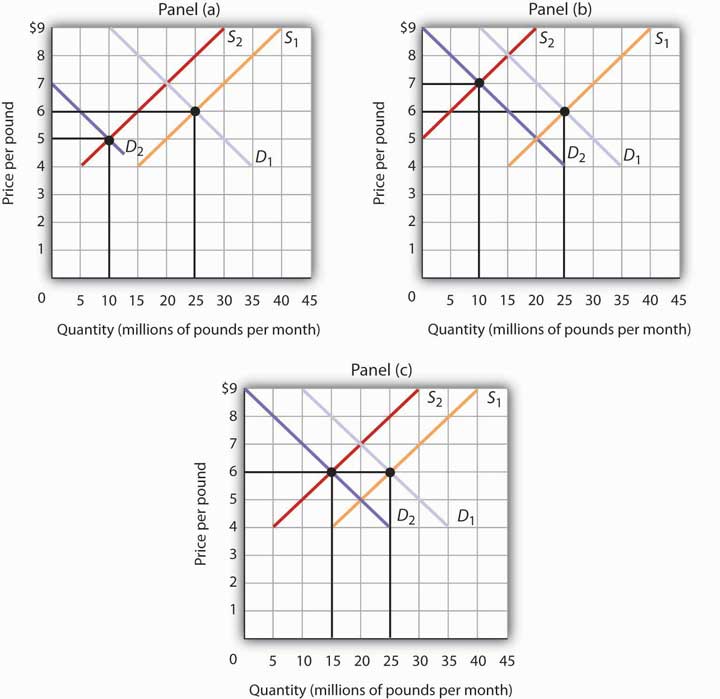
Both the demand and the supply of coffee subtract. Since decreases in demand and supply, considered separately, each cause equilibrium quantity to fall, the impact of both decreasing simultaneously means that a new equilibrium quantity of coffee must exist less than the old equilibrium quantity. In Panel (a), the demand curve shifts farther to the left than does the supply curve, so equilibrium price falls. In Console (b), the supply curve shifts farther to the left than does the demand bend, so the equilibrium price rises. In Panel (c), both curves shift to the left by the same amount, and so equilibrium cost stays the aforementioned.
If the need curve shifts farther to the left than does the supply curve, as shown in Console (a) of Effigy 3.19 "Simultaneous Decreases in Demand and Supply", then the equilibrium price will be lower than information technology was before the curves shifted. In this instance the new equilibrium price falls from $half-dozen per pound to $5 per pound. If the shift to the left of the supply curve is greater than that of the demand curve, the equilibrium price will be higher than it was before, every bit shown in Console (b). In this case, the new equilibrium cost rises to $7 per pound. In Console (c), since both curves shift to the left by the aforementioned amount, equilibrium price does not change; it remains $6 per pound.
Regardless of the scenario, changes in equilibrium toll and equilibrium quantity resulting from two different events need to exist considered separately. If both events cause equilibrium toll or quantity to move in the same direction, then conspicuously price or quantity tin can be expected to movement in that direction. If 1 upshot causes cost or quantity to rise while the other causes it to fall, the extent by which each curve shifts is critical to figuring out what happens. Effigy three.xx "Simultaneous Shifts in Need and Supply" summarizes what may happen to equilibrium price and quantity when demand and supply both shift.
Figure three.20 Simultaneous Shifts in Demand and Supply
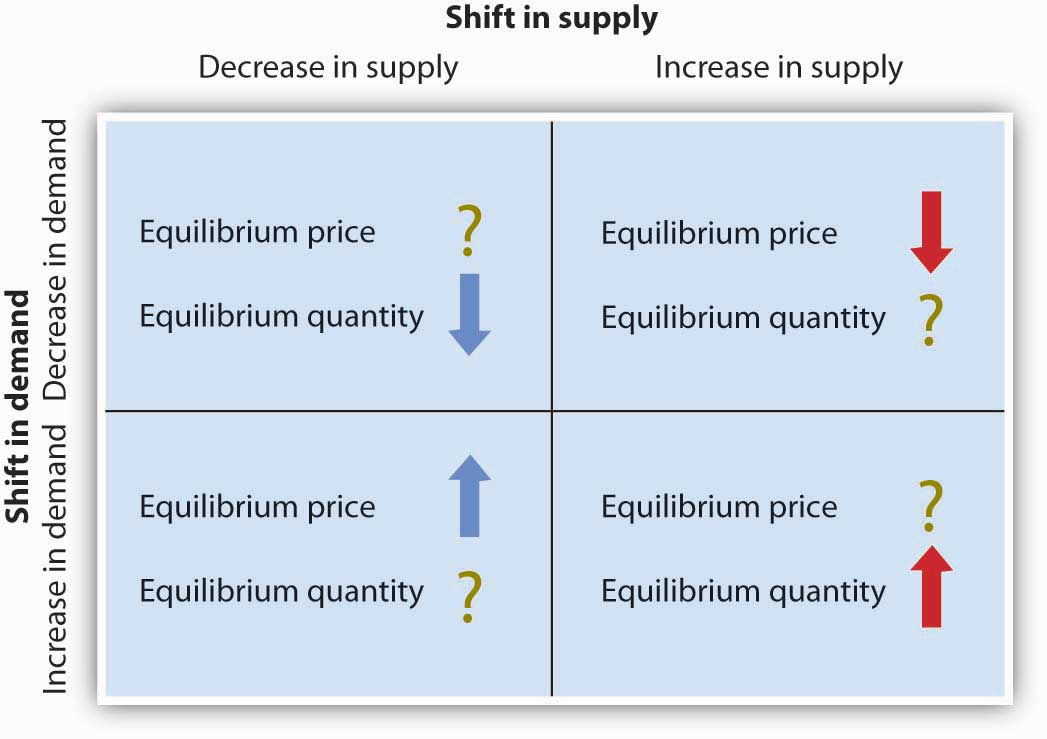
If simultaneous shifts in demand and supply cause equilibrium price or quantity to move in the aforementioned management, then equilibrium price or quantity clearly moves in that direction. If the shift in one of the curves causes equilibrium toll or quantity to rise while the shift in the other curve causes equilibrium cost or quantity to fall, then the relative amount by which each bend shifts is critical to figuring out what happens to that variable.
Every bit demand and supply curves shift, prices adjust to maintain a balance between the quantity of a good demanded and the quantity supplied. If prices did non adjust, this balance could not be maintained.
Notice that the demand and supply curves that we accept examined in this chapter have all been drawn equally linear. This simplification of the real world makes the graphs a bit easier to read without sacrificing the essential betoken: whether the curves are linear or nonlinear, need curves are downward sloping and supply curves are generally upwards sloping. As circumstances that shift the need curve or the supply curve alter, we can clarify what volition happen to toll and what will happen to quantity.
An Overview of Demand and Supply: The Circular Flow Model
Implicit in the concepts of demand and supply is a constant interaction and adjustment that economists illustrate with the circular menstruation model. The round menstruation model provides a expect at how markets piece of work and how they are related to each other. Information technology shows flows of spending and income through the economy.
A neat deal of economic activity tin exist idea of equally a process of exchange betwixt households and firms. Firms supply goods and services to households. Households buy these goods and services from firms. Households supply factors of production—labor, upper-case letter, and natural resources—that firms require. The payments firms make in exchange for these factors stand for the incomes households earn.
The menses of appurtenances and services, factors of production, and the payments they generate is illustrated in Figure 3.21 "The Circular Flow of Economic Activity". This round period model of the economic system shows the interaction of households and firms as they exchange goods and services and factors of production. For simplicity, the model here shows only the private domestic economy; it omits the government and foreign sectors.
Figure three.21 The Circular Flow of Economic Activity
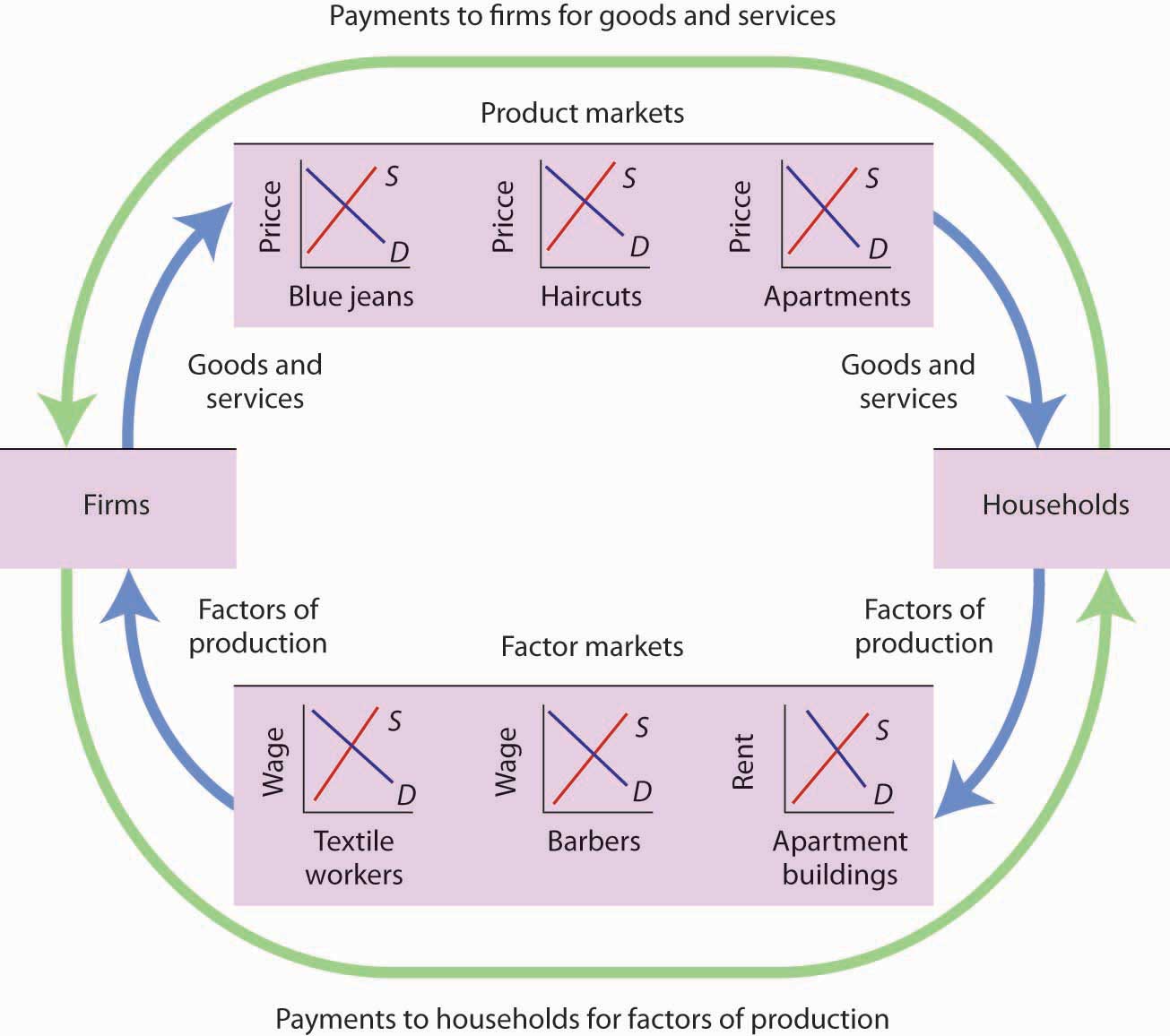
This simplified circular flow model shows flows of spending betwixt households and firms through product and factor markets. The inner arrows bear witness appurtenances and services flowing from firms to households and factors of production flowing from households to firms. The outer flows show the payments for appurtenances, services, and factors of product. These flows, in plough, stand for millions of individual markets for products and factors of production.
The round flow model shows that goods and services that households need are supplied past firms in production markets. The exchange for goods and services is shown in the top half of Effigy 3.21 "The Circular Period of Economic Activeness". The bottom one-half of the exhibit illustrates the exchanges that have place in factor markets. gene markets are markets in which households supply factors of product—labor, capital, and natural resources—demanded by firms.
Our model is called a circular flow model because households use the income they receive from their supply of factors of production to buy goods and services from firms. Firms, in plough, utilize the payments they receive from households to pay for their factors of product.
The demand and supply model developed in this affiliate gives u.s.a. a basic tool for understanding what is happening in each of these product or factor markets and too allows u.s. to run into how these markets are interrelated. In Figure three.21 "The Circular Flow of Economical Activeness", markets for iii goods and services that households want—blue jeans, haircuts, and apartments—create demands by firms for cloth workers, barbers, and apartment buildings. The equilibrium of supply and demand in each marketplace determines the price and quantity of that detail. Moreover, a change in equilibrium in one market will touch on equilibrium in related markets. For instance, an increase in the demand for haircuts would lead to an increase in need for barbers. Equilibrium cost and quantity could rise in both markets. For some purposes, it will be adequate to simply look at a single market, whereas at other times we will want to look at what happens in related markets as well.
In either case, the model of need and supply is ane of the well-nigh widely used tools of economic analysis. That widespread use is no blow. The model yields results that are, in fact, broadly consistent with what we discover in the marketplace. Your mastery of this model will pay big dividends in your written report of economic science.
Key Takeaways
- The equilibrium price is the price at which the quantity demanded equals the quantity supplied. Information technology is adamant past the intersection of the demand and supply curves.
- A surplus exists if the quantity of a good or service supplied exceeds the quantity demanded at the current toll; it causes downward pressure on cost. A shortage exists if the quantity of a good or service demanded exceeds the quantity supplied at the current price; information technology causes upward force per unit area on toll.
- An increase in demand, all other things unchanged, will crusade the equilibrium cost to ascension; quantity supplied will increment. A decrease in need will crusade the equilibrium price to autumn; quantity supplied will decrease.
- An increase in supply, all other things unchanged, will cause the equilibrium price to fall; quantity demanded will increase. A subtract in supply will cause the equilibrium cost to rise; quantity demanded will decrease.
- To decide what happens to equilibrium price and equilibrium quantity when both the supply and need curves shift, you must know in which management each of the curves shifts and the extent to which each curve shifts.
- The round flow model provides an overview of demand and supply in production and factor markets and suggests how these markets are linked to one another.
Attempt It!
What happens to the equilibrium price and the equilibrium quantity of DVD rentals if the toll of cinema tickets increases and wages paid to DVD rental store clerks increase, all other things unchanged? Be sure to bear witness all possible scenarios, as was washed in Figure 3.19 "Simultaneous Decreases in Need and Supply". Again, you do not need bodily numbers to arrive at an answer. Just focus on the general position of the curve(s) before and later on events occurred.
Example in Signal: Demand, Supply, and Obesity
Figure 3.22
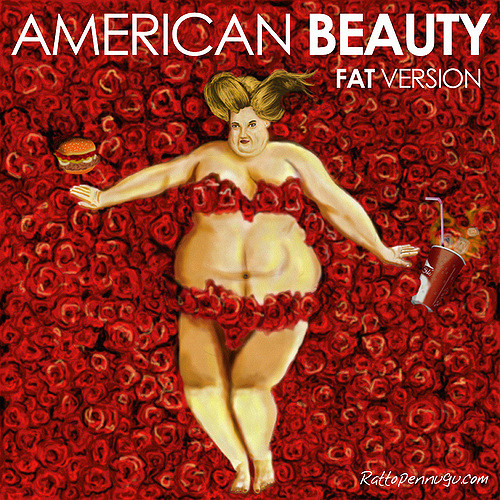
Why are so many Americans fatty? Put so crudely, the question may seem rude, but, indeed, the number of obese Americans has increased by more fifty% over the last generation, and obesity may now be the nation's number 1 wellness problem. According to Sturm Roland in a contempo RAND Corporation report, "Obesity appears to have a stronger clan with the occurrence of chronic medical conditions, reduced physical wellness-related quality of life and increased wellness care and medication expenditures than smoking or trouble drinking."
Many explanations of ascent obesity advise higher demand for nutrient. What more than apt picture of our sedentary life style is at that place than spending the afternoon watching a ballgame on TV, while eating chips and salsa, followed by a dinner of a lavishly topped, take-out pizza? Higher income has also undoubtedly contributed to a rightward shift in the need curve for food. Plus, any additional food intake translates into more weight increase because we spend so few calories preparing information technology, either directly or in the procedure of earning the income to purchase it. A report by economists Darius Lakdawalla and Tomas Philipson suggests that about 60% of the recent growth in weight may be explained in this way—that is, demand has shifted to the correct, leading to an increment in the equilibrium quantity of food consumed and, given our less strenuous life styles, fifty-fifty more than weight gain than can be explained simply by the increased corporeality nosotros are eating.
What accounts for the remaining xl% of the weight proceeds? Lakdawalla and Philipson further reason that a rightward shift in demand would by itself lead to an increase in the quantity of food every bit well as an increase in the price of food. The trouble they accept with this caption is that over the postal service-Earth War 2 menstruum, the relative price of food has declined by an boilerplate of 0.2 percentage points per year. They explicate the fall in the toll of food by arguing that agricultural innovation has led to a substantial rightward shift in the supply curve of food. As shown, lower food prices and a higher equilibrium quantity of food have resulted from simultaneous rightward shifts in need and supply and that the rightward shift in the supply of food from South ane to S two has been substantially larger than the rightward shift in the demand curve from D 1 to D ii.
Figure 3.23

Sources: Roland, Sturm, "The Effects of Obesity, Smoking, and Problem Drinking on Chronic Medical Bug and Health Care Costs," Health Diplomacy, 2002; 21(two): 245–253. Lakdawalla, Darius and Tomas Philipson, "The Growth of Obesity and Technological Change: A Theoretical and Empirical Test," National Bureau of Economical Enquiry Working Paper no. w8946, May 2002.
Answer to Attempt Information technology! Problem
An increase in the price of movie theater tickets (a substitute for DVD rentals) will cause the need curve for DVD rentals to shift to the right. An increase in the wages paid to DVD rental store clerks (an increase in the cost of a factor of production) shifts the supply curve to the left. Each event taken separately causes equilibrium price to rise. Whether equilibrium quantity will be higher or lower depends on which curve shifted more.
If the demand curve shifted more, then the equilibrium quantity of DVD rentals will rise [Panel (a)].
If the supply curve shifted more, then the equilibrium quantity of DVD rentals volition autumn [Panel (b)].
If the curves shifted by the same corporeality, then the equilibrium quantity of DVD rentals would non change [Console (c)].
Figure three.24
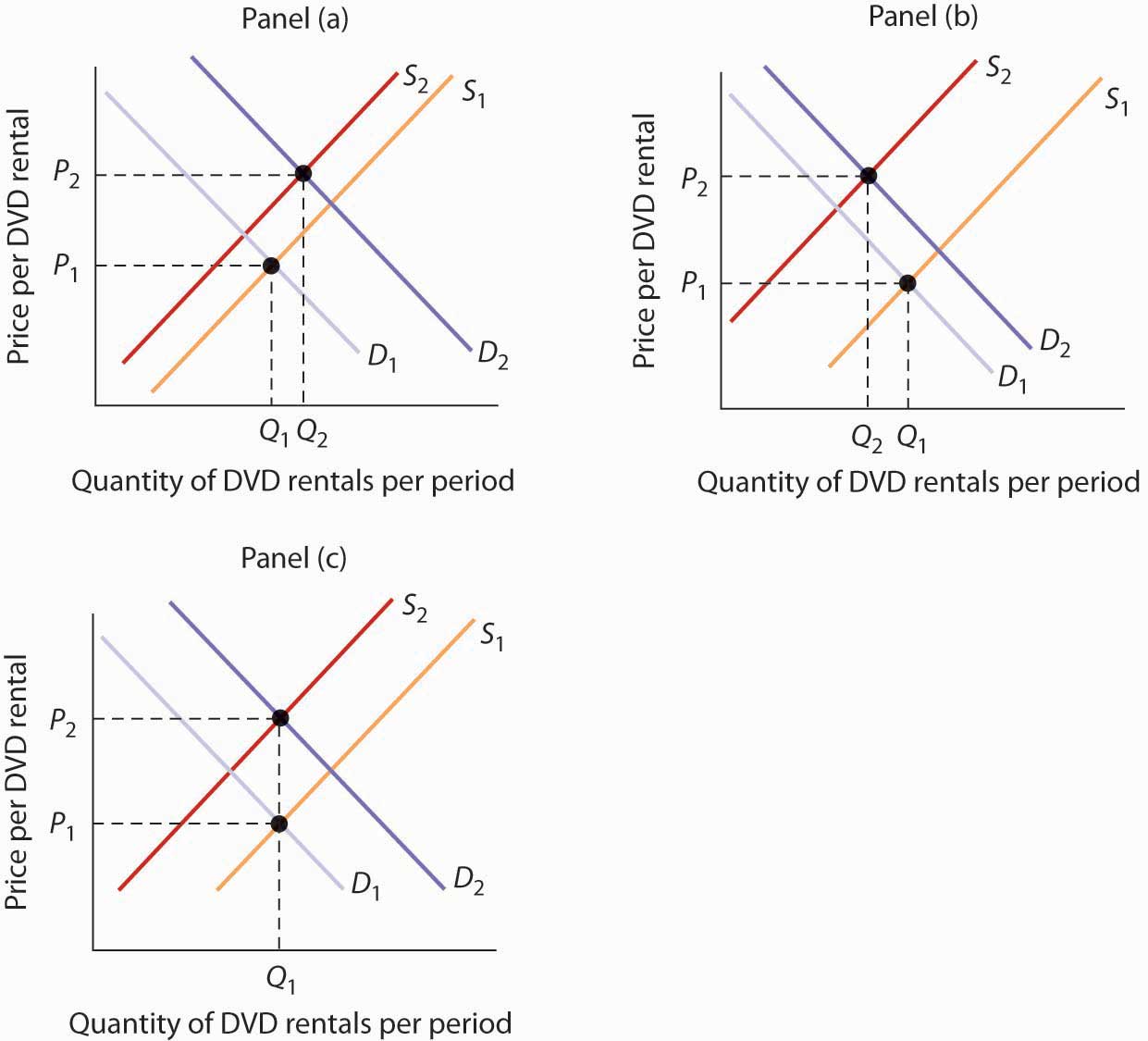
rodriguezruliteren1979.blogspot.com
Source: https://open.lib.umn.edu/principleseconomics/chapter/3-3-demand-supply-and-equilibrium/
0 Response to "explain in complete sentences what happens to supply or demand and what the new equilibrium is when"
Post a Comment